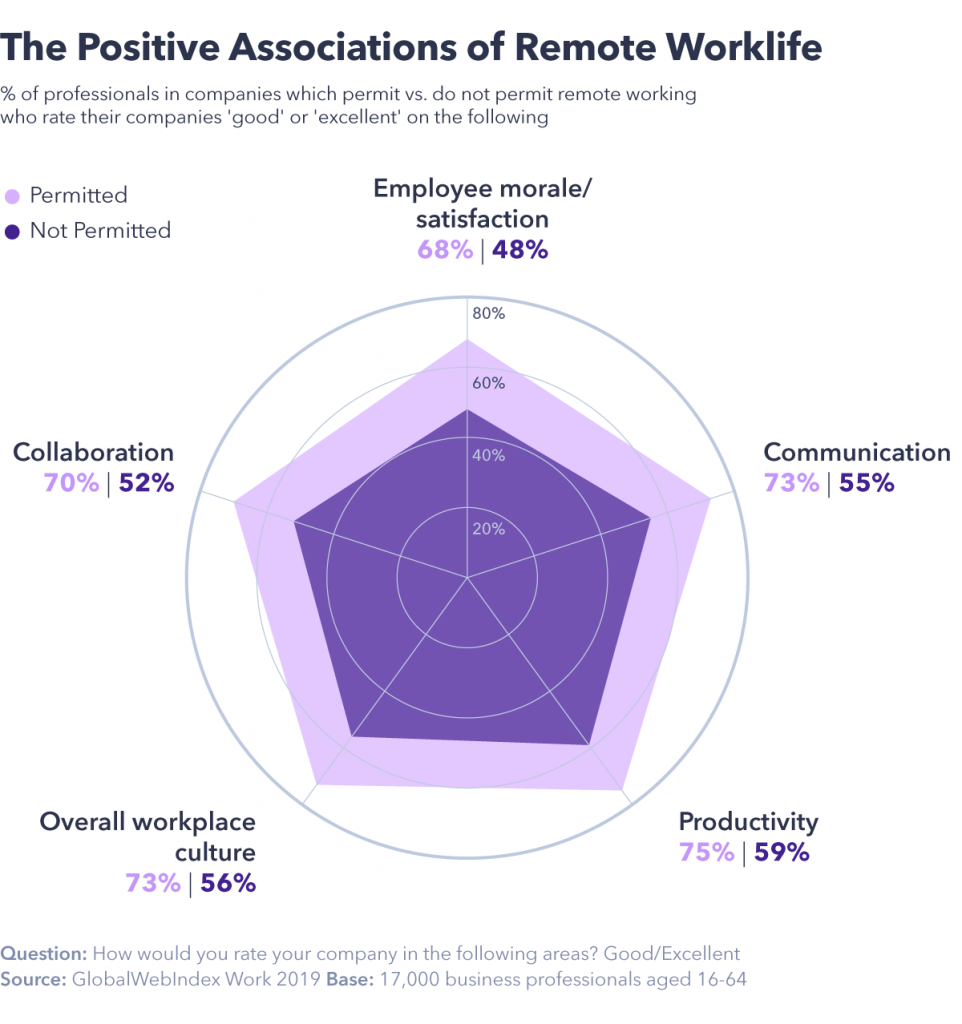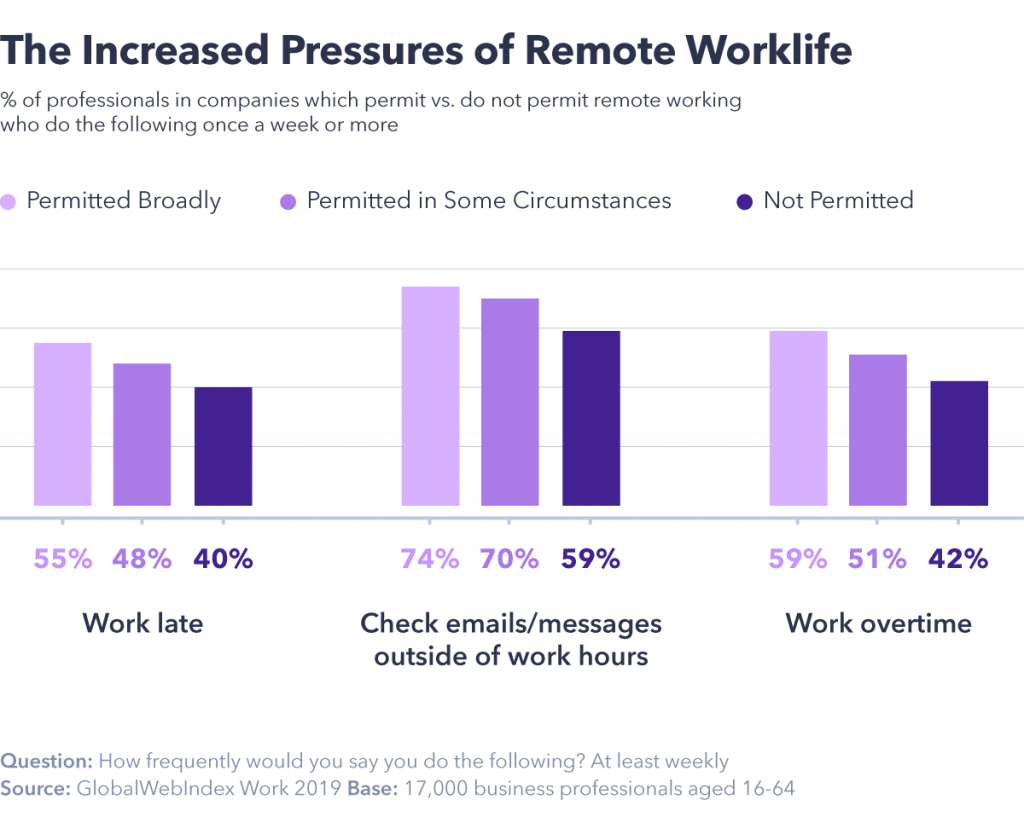In recent years one of the major changes in work culture has been the growth of the distributed workforce.
Enabled by the rise of technology, companies all over the world are increasingly allowing – and sometimes actively encouraging – remote working or other flexible arrangements.
And because of this evolution, “clocking in” has become a figurative expression.
Technology as a catalyst
Nothing has enabled the rise of the remote workplace more than technological advancements of the last twenty years.
The development of videoconferencing, collaboration software, and better network security all represent crucial elements of this.
At the heart of these developments is perhaps the most influential factor: the spread of high-speed internet access.
In the U.S., less than 30% of adults had broadband access in their homes in 2005; by 2019, this had risen to 73%. Broadband access in the European Union has expanded at similar rates.
These advancements, however, have been largely contained to the developed world, with total internet penetration levels significantly lower in places like Southern Asia (36%), Eastern Africa (27%), and the Caribbean (48%).
With the rise of high-speed internet access in developed markets, the nature of “remote work” has changed and expanded. Most employers have become increasingly tolerant, and even encouraging, of this type of workplace benefit.
Our research into knowledge professionals indicates that across industries, three-quarters of people report that their employers permit remote working to some extent. For one quarter of workers, working remotely is broadly accepted.
No longer are these arrangements the domain of lower-paid jobs like telemarketing. Rather, we see that tolerance for remote working actually increases as seniority and achievement level in the workplace increases:
83% of those in executive management positions report being permitted to work remotely, while 63% of general office workers have the same benefit.
Although remote working is permitted across industries, the technology and communication, management training, and arts, media, and marketing sectors lead the way here.
Adjacent flexible benefits, like agile working, are also quite high. For example, 56% of global professionals are permitted to “hot desk”, with 25% saying they are broadly permitted to engage in this practice.
The influence of youth and agility
Younger professionals report a broader acceptance of remote working in their companies.
Among 16-24 year-old workers, 80% say that remote working is permitted. Similarly high rates exist among 25-34 year-olds, but rates begin to decline as workers get older. Among 55-64 year-olds, 66% report their workplace permits remote working.
Additionally, flexible workplace culture seems to be the hallmark of younger, smaller companies.
Among companies that were founded less than 11 years ago, remote working is accepted generally by over 80%, and accepted widely by about one-third.
These rates decline for more established companies, with a significant decline among companies that have been around for more than twenty years. While there is an interplay here, with younger companies often attracting younger workers, an additional factor is present: younger workers demand more work-life balance.
As they’ve come of age and entered the workforce during the years of rapid workplace transformation, flexibility is now part of the package for many young professionals.
Millennials, having entered the workforce en masse in the last 15 years, have driven much of this change.
According to Deloitte’s Millennial Survey, a good work/life balance is the most important factors for young professionals evaluating job opportunities.
Following this are (2) opportunities to progress and (3) workplace flexibility (i.e. remote working, flexible working). This is indicative that for younger generations, a balance of lifestyle benefits in the workplace often outweigh other more traditional markers of what constitutes a “good” prospective job.
And they may have the right idea. While there are challenges, especially from the perspective of employers, the benefits of remote working and other flexible practices are evident.
Productivity gets a boost
Among global professionals, remote working is often associated with better personal outcomes.
Those who work for employers that permit remote working are more inclined to rate their companies as “good” or “excellent” for employee morale, communication, productivity, collaboration, and overall culture.
What’s more, other research focusing on workplace practices and satisfaction reinforces these results.
A Gallup poll in 2017 found that an optimal balance for productivity exists, and it leans toward more frequent remote working.
Based on the poll’s findings, American professionals who spent between 60-80% of their time working remotely reported being the most engaged with their work.

Physical vs. psychological constraints
Greater levels of productivity come with a cost to employees, however.
Further interrogating the data suggests that remote working is associated with a tendency to work longer and harder.
The likelihood of doing things like working late, working overtime, and answering emails or messages outside of office hours directly increases as workplace tolerance toward remote working increases.
Where working remotely is broadly permitted, employees are more likely to work late regularly (55%) vs. where it’s permitted with limitations (48%) and where it’s not permitted at all (40%).
The same pattern emerges among communication and project workload. Where working remotely is broadly permitted, 36% of employees are juggling 5 or more projects simultaneously, compared with 29% of those in companies where it is accepted on a more limited basis, and only 19% of those in companies that do not permit this practice at all.
The root of this drive to work longer, take on more projects, and maintain constant communication when working remotely is not entirely clear.
A likely factor at play, however, is the pressure to emphasize one’s commitment to the job when a visible, physical presence means that this is no longer obvious to colleagues and management.
While free from limitations of a traditional work environment, the constraints of remote workers take on a more psychological nature.

The evolution of the workplace
The growth of a distributed workforce is only one element of how our work culture has changed over time.
In the last couple of decades, this change has been dramatic, catalyzed by global economic movements and rapid developments in technology.
For more insight into how these and other factors have shaped our modern way of working, sign up to receive our new report on the Evolution of the Workplace, to be released October 15th.

